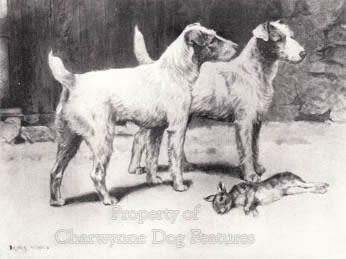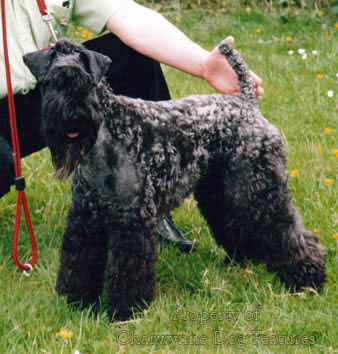680 EMERGENCE OF TERRIER
EMERGENCE OF TERRIER
by David Hancock
.jpg) “The Terrier is querulous, fretful and irascible, high-spirited and alert when brought into action; if he has not unsubdued perseverance like the bulldog, he has rapidity of attack, managed with art, and sustained with spirit; it is not what he will bear, but what he will inflict …as his courage is great, so is his extensive genius: he will trace with the Foxhound, hunt with the Beagle, find for the Greyhound, or beat with the Spaniel.”
“The Terrier is querulous, fretful and irascible, high-spirited and alert when brought into action; if he has not unsubdued perseverance like the bulldog, he has rapidity of attack, managed with art, and sustained with spirit; it is not what he will bear, but what he will inflict …as his courage is great, so is his extensive genius: he will trace with the Foxhound, hunt with the Beagle, find for the Greyhound, or beat with the Spaniel.”
Those epic words by Sydenham Edwards, in his ‘Cynographia Britannica’ of 1800 tell you more about the terrier tribe than some books with 100 pages on them. He has succinctly captured their role, their nature, their value and their soul. Just over two centuries before him, the Oxford scholar Dr Caius had listed them as part of the hound family and suggested their name came about ‘because they (after the manner and custom of ferrets, in searching for conies) creep into the ground, and by that means make afraid, nip, and bite the fox and the badger…’ Thirty years before that, in 1543, Dr Still had composed a poem, which read:.jpg)
‘Body and limb go cold,
Both foot and hand go bare;
God send teroures so bold, so bold,
Heart will harbour no care.’
and stressed that their boldness was a feature even then. A century later, Nicholas Cox, in his ‘The Gentleman’s Recreation’of 1667, described them as of two sorts, one with legs more or less crooked with short coats and another straighter in the leg and with long jackets. Another century passes, and we find Daniel, in his ‘Field Sports’ writing: “There are two sorts of terriers, the one short-legged, long-backed, very strong, and most commonly of a black or yellowish colour, mixed with white; the other is smooth-haired and beautifully formed, having a shorter body and a more sprightly appearance, is generally of a reddish-brown colour, or black with tanned legs.” Both were relying on French descriptions of Basset Hounds, as did Turberville, Blome and their followers. The authentic voice of the British terrier-men was not being heard, mainly because they did not come from the educated or monied classes.
The first reliable description of variety in our terriers is provided by Taplin in his ‘Sportsman’s Dictionary’ of 1803: “Terriers of even the best blood are bred of all colours: red, black (with tan faces, flanks, feet, and legs) brindled sandy; some few brown pied, white pied and pure white; the other soft and smooth…but the rough breed must be acknowledged the most severe and invincible biter of the two.” It’s significant that no description of a terrier, down the ages, has been deemed complete without mention of the terrier-spirit, the combative attitude of this group of dogs.
I always think of terriers in four sub-groups: the basset/dachshund type as exemplified in the Dandie Dinmont, the Skye and indeed some so-called Jack Russells; the Beagle or small scenthound type as in the Fox Terrier, Manchester, or the Pinscher breeds; the ‘griffon’ or coarse-haired type as in the Border, Lakeland, the terriers of Scotland less the Dandie and Skye, Irish, Sealyham, Airedale, the Schnauzer varieties, Kerry Blue, Wheaten and perhaps the Smoushond of Holland; and then the hybrids, the Bedlington, the English White (that was) and the Bull Terriers.
It is of interest that the same factors which apply to the inheritance of scenthounds apply to wire and smooth-haired Fox Terriers. A narrow head is dominant over the broader hound-like head. The sharp nose is dominant over the blunt nose; wire hair is dominant over short hair and the short legs of the Dachshund, Basset Hound and Scottish Terrier are (incompletely) dominant over the normal longer legs of the Fox Terrier. The colour of the Dachshund, whether wire, long-haired or smooth, is determined by the same determiners which affect scenthounds. In 1916, Wellman wrote of experimental crosses between Fox Terriers and Basset Hounds in which the vast majority of the progeny were black and tan and short-legged. From these facts it can be seen that in time it would not be difficult to produce a narrower-headed, sharper-muzzled, shorter-legged, wire-coated earth-dog from a hound origin.
The terrier breeds are however likely to have more than just a hound background. As Darwin himself once wrote: “A breed, like a dialect of language, can hardly be said to have a distinct origin. A man preserves and breeds from an individual with some slight deviation of structure, or takes more care than usual in mating his best animals and thus improves them…When further improved by the same slow and gradual process, they will spread more widely and will be recognised as something distinct and valuable, and will then probably first receive a provincial name.” In such a way did we develop our Rothbury, Manchester, Aberdeen, Reedwater, Glen of Imaal, Patterdale, Norfolk, Poltalloch, Clydesdale and Yorkshire terriers. The root stock of many being the old rough-coated black and tan common terrier of Britain, used by many hunts before hound-marked dogs became fashionable.
It is not wise to regard the many nineteenth century writers on dogs as authorities on terriers. Firstly, they copied from each other, sometimes consolidating falsehoods which are still today regarded as facts. Secondly, as so many did before them, they often wittingly or unwittingly plagiarised the masterly work of Jacques du Fouilloux, (his ‘La Venerie’ of 1560), a few even passing off his words as their own. He was writing, not surprisingly, as did De Foix in his ‘Livre de Chasse’ of 1401, (brought to us as ‘Master of Game’ by Edward, Duke of York), of French dogs. Youatt, ‘Idstone’, ‘Stonehenge’ and Dalziel, for all their valuable words on dogs in Victorian times, are not so well informed on terriers. Vero Shaw gives much more detail; Robert Leighton, into Edwardian times, provides even more information on the developing show breeds of terrier. But it is not until quite late in the 20th century that we get coverage of working terriers. At last, it is not educated men writing secondhand about dogs of which they have little knowledge, but informed writers: Sir Jocelyn Lucas, Pierce O’Conor, Rosslyn Bruce, Dan Russell, Brian Plummer and their like, covering a subject they are well acquainted with and working terriers receiving long overdue attention. 
The showing of dogs, launched in the 1870s, mushroomed at the end of the nineteenth century and this expansion continued into the twentieth century despite two world wars. Individual breeds of terrier once recognised by the Kennel Club as such, became isolated genetically, with some breeds originating in a relatively tiny gene pool. Foundation stock in the sporting terrier breeds often came from hunt kennels or working sources and so the breeding basis was sound. Gradually and remorselessly however the coefficients of inbreeding have in some of these breeds reached unacceptable levels and a rethink is now urgently required. Away from the show ring, unrecognised breeds, like the Fell, Sporting Lucas and Patterdale have thrived, not in large numbers, but in true terrier form. Newly created breeds like the Cesky and Plummer Terriers are more popular than some age-old breeds, with the ubiquitous Jack Russells replacing the once heavily fancied Fox Terrier. If the twentieth century was the one in which the terrier breeds ‘arrived’, then the twenty-first century could be the one in which the terrier varieties ‘came and went’. What really must continue is the unquenchable spirit in this type of dog; breeds may in time just lose favour, but any breed bearing the description of terrier has to have that very special ‘get-up-and-go’, the never-say-die attitude of the true earth-dog. May that spirit never be lost; it is a precious feature of the canine world and the terrier is very much Britain’s contribution to the sporting dogs of the world.